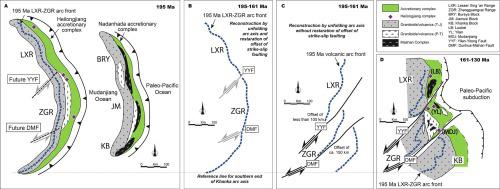当前位置:
X-MOL 学术
›
J. Asian Earth Sci.
›
论文详情
Our official English website, www.x-mol.net, welcomes your
feedback! (Note: you will need to create a separate account there.)
Accretion, subduction erosion, and tectonic extrusion during Late Paleozoic to Mesozoic orogenesis in NE China
Journal of Asian Earth Sciences ( IF 2.7 ) Pub Date : 2020-06-01 , DOI: 10.1016/j.jseaes.2020.104258 Arthur Aouizerat , Wenjiao Xiao , Karel Schulmann , Brian F. Windley , Jianbo Zhou , Jinjiang Zhang , Songjian Ao , Dongfang Song , Patrick Monie , Kai Liu
Journal of Asian Earth Sciences ( IF 2.7 ) Pub Date : 2020-06-01 , DOI: 10.1016/j.jseaes.2020.104258 Arthur Aouizerat , Wenjiao Xiao , Karel Schulmann , Brian F. Windley , Jianbo Zhou , Jinjiang Zhang , Songjian Ao , Dongfang Song , Patrick Monie , Kai Liu

|
Abstract The high-pressure Heilongjiang Complex records a long and complicated evolution from the late Paleozoic to Mesozoic in NE China, which is still subject to controversy. In this paper we present a new detailed study including structural, geochemical and geochronological analyses (Ar–Ar dating on metamorphic minerals, U-Pb SIMS dating on zircons). Two main periods of oceanward accretionary growth are identified between 305 Ma and 195 Ma and around 112–101 Ma. These periods of accretionary growth were associated with the emplacement of voluminous magmatism, slab roll-back with continental back-arc extension, and growth of a forearc accretionary prism. Between these periods of accretionary growth, a major phase of regional subduction erosion took place between 195 Ma and 142 Ma at the eastern edge of the Songliao Block. The main effects of this subduction erosion phase were that regional Jurassic-early Cretaceous extrusion overlapped with Mesozoic accretion and erosion in NE China, which disturbed the initial orogenic architecture. With a review of relevant zircon ages of this accretionary orogen, we unravel the complicated geodynamic history of accretion, subduction erosion and tectonic extrusion that shaped NE China from the late Paleozoic to Mesozoic.
更新日期:2020-06-01











































 京公网安备 11010802027423号
京公网安备 11010802027423号